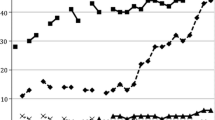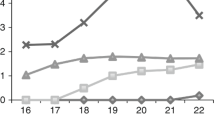Abstract
Examining age, time period, and cohort/generational changes in sexual experience is key to better understanding sociocultural influences on sexuality and relationships. Americans born in the 1980s and 1990s (commonly known as Millennials and iGen) were more likely to report having no sexual partners as adults compared to GenX’ers born in the 1960s and 1970s in the General Social Survey, a nationally representative sample of American adults (N = 26,707). Among those aged 20–24, more than twice as many Millennials born in the 1990s (15 %) had no sexual partners since age 18 compared to GenX’ers born in the 1960s (6 %). Higher rates of sexual inactivity among Millennials and iGen also appeared in analyses using a generalized hierarchical linear modeling technique known as age–period–cohort analysis to control for age and time period effects among adults of all ages. Americans born early in the 20th century also showed elevated rates of adult sexual inactivity. The shift toward higher rates of sexual inactivity among Millennials and iGen’ers was more pronounced among women and absent among Black Americans and those with a college education. Contrary to popular media conceptions of a “hookup generation” more likely to engage in frequent casual sex, a higher percentage of Americans in recent cohorts, particularly Millennials and iGen’ers born in the 1990s, had no sexual partners after age 18.

Similar content being viewed by others
Notes
With the first iGen’ers turning 18 in 2013, most datasets (including the one we analyze here) include only the first few birth years of this generation, and other studies do not include them at all. Thus, some results will refer to Millennials only, and others to Millennials and iGen.
We also considered a model including a cubic effect for age, but did not have confidence in its reliability due to small sample sizes among participants over age 82 (when sample sizes by year of age dip below n = 100).
APC analyses do not employ traditional statistical significance testing, though they can generate 95 % confidence intervals. Therefore, where appropriate, we examined whether the 95 % confidence intervals for two different means overlapped or not and used that as the determination of whether a difference was statistically significant.
References
Arnett, J. J. (2005). Emerging adulthood. Oxford: Oxford University Press.
Bates, D., Maechler, M., Bolker, B., & Walker, S. (2014). lme4: Linear mixed-effects models using Eigen and S4. R package version 1.1-7. http://CRAN.R-project.org/package=lme4. Accessed 5 July 2016.
Bennett, S. E., & Assefi, N. P. (2005). School-based teenage pregnancy prevention programs: A systematic review of randomized controlled trials. Journal of Adolescent Health, 36, 72–81.
Bersamin, M. M., Fisher, D. A., Walker, S., Hill, D. L., & Grube, J. W. (2007). Defining virginity and abstinence: Adolescents’ interpretations of sexual behaviors. Journal of Adolescent Health, 41, 182–188.
Brückner, H., & Bearman, P. (2005). After the promise: The STD consequences of adolescent virginity pledges. Journal of Adolescent Health, 36, 271–278.
Byers, E. S., Henderson, J., & Hobson, K. M. (2009). University students’ definitions of sexual abstinence and having sex. Archives of Sexual Behavior, 38, 665–674.
Campbell, W. K., Campbell, S., Siedor, L. E., & Twenge, J. M. (2015). Generational differences are real and useful. Industrial and Organizational Psychology: Perspectives on Science and Practice, 8, 324–408.
Centers for Disease Control. (2016). Trends in the prevalence of sexual behavior and HIV testing. National YTBS: 1991–2015. http://www.cdc.gov/healthyyouth/data/yrbs/pdf/2015/ss6506_updated.pdf. Accessed 5 July 2016.
Eaton, D. K., Lowry, R., Brener, N. D., Kann, L., Romero, L., & Wechsler, H. (2011). Trends in human immunodeficiency virus–and sexually transmitted disease–related risk behaviors among US high school students, 1991–2009. American Journal of Preventive Medicine, 40, 427–433.
Fielder, R. L., & Carey, M. P. (2010). Prevalence and characteristics of sexual hookups among first-semester female college students. Journal of Sex and Marital Therapy, 36, 346–359.
Finer, L. B., & Philbin, J. M. (2013). Sexual initiation, contraceptive use, and pregnancy among young adolescents. Pediatrics, 131, 886–891.
Grunseit, A., Richters, J., Crawford, J., Song, A., & Kippax, S. (2005). Stability and change in sexual practices among first-year Australian university students (1990–1999). Archives of Sexual Behavior, 34, 557–568.
Haydon, A. A., Cheng, M. M., Herring, A. H., McRee, A. L., & Halpern, C. T. (2014). Prevalence and predictors of sexual inexperience in adulthood. Archives of Sexual Behavior, 43, 221–230.
Heywood, W., Patrick, K., Smith, A. M. A., & Pitts, M. K. (2015). Associations between early first sexual intercourse and later sexual and reproductive outcomes: A systematic review of population-based data. Archives of Sexual Behavior, 44, 531–569.
Hoglund, J., Jern, P., Sandnabba, N. K., & Santtila, P. (2014). Finnish women and men who self-report no sexual attraction in the past 12 months: Prevalence, relationship status, and sexual behavior history. Archives of Sexual Behavior, 43, 879–889.
Hull, S. J., Hennessy, M., Bleakley, A., Fishbein, M., & Jordan, A. (2011). Identifying the causal pathways from religiosity to delayed adolescent sexual behavior. Journal of Sex Research, 48, 543–553.
Jemmott, J. B., Jemmott, L. S., & Fong, G. T. (2010). Efficacy of a theory-based abstinence-only intervention over 24 months: A randomized controlled trial with young adolescents. Archives of Pediatrics and Adolescent Medicine, 164, 152–159.
Jung, J. H. (2015). A cross-national analysis of religion and attitudes toward premarital sex: Do economic contexts matter? Sociological Perspectives. doi:10.1177/0731121415595428.
Kaplan, D. L., Jones, E. J., Olson, E. C., & Yunzal-Butler, C. B. (2013). Early age of first sex and health risk in an urban adolescent population. Journal of School Health, 83, 350–356.
Kirby, D. B. (2008). The impact of abstinence and comprehensive sex and STD/HIV education programs on adolescent sexual behavior. Sexuality Research & Social Policy, 5, 18–27.
Kohler, P. K., Manhart, L. E., & Lafferty, W. E. (2008). Abstinence-only and comprehensive sex education and the initiation of sexual activity and teen pregnancy. Journal of Adolescent Health, 42, 344–351.
Kuperberg, A., & Padgett, J. E. (2016). Partner meeting contexts and risky behavior in college students’ other-sex and same-sex hookups. Journal of Sex Research. doi:10.1080/00224499.2015.1124378.
Lerner, J. E., & Hawkins, R. L. (2016). Welfare, liberty, and security for all? U.S. sex education policy and the 1996 Title V Section 510 of the Social Security Act. Archives of Sexual Behavior, 45, 1027–1038.
Magnusson, B. M., Masho, S. W., & Lapane, K. L. (2012). Early age at first intercourse and subsequent gaps in contraceptive use. Journal of Women’s Health, 21, 73–79.
Martino, S. C., Elliott, M. N., Collins, R. L., Kanouse, D. E., & Berry, S. H. (2008). Virginity pledges among the willing: Delays in first intercourse and consistency of condom use. Journal of Adolescent Health, 43, 341–348.
Monto, M. A., & Carey, A. G. (2014). A new standard of sexual behavior? Are claims associated with the “hookup culture” supported by General Social Survey data? Journal of Sex Research, 51, 605–615.
Petersen, J. L., & Hyde, J. S. (2010). A meta-analytic review of research on gender differences in sexuality, 1993–2007. Psychological Bulletin, 136(1), 21–38.
Pew Research Center. (2014). Millennials in adulthood: Detached from institutions, networked with friends. Retrieved March 7, 2014 from http://www.pewsocialtrends.org/2014/03/07/millennials-in-adulthood/.
Pew Research Center. (2015). More Millennials living with family despite improved job market. Retrieved July 29, 2015 from http://www.pewsocialtrends.org/2015/07/29/more-millennials-living-with-family-despite-improved-job-market/.
R Core Team. (2014). R: A language and environment for statistical computing [Computer software]. Vienna: R Foundation for Statistical Computing.
Regnerus, M., & Uecker, J. (2011). Premarital sex in America: How young Americans meet, mate, and think about marrying. Oxford: Oxford University Press.
Reiber, C., & Garcia, J. R. (2010). Hooking up: Gender differences, evolution, and pluralistic ignorance. Evolutionary Psychology, 8, 390–404.
Rosenbaum, J. E. (2009). Patient teenagers? A comparison of the sexual behavior of virginity pledgers and matched nonpledgers. Pediatrics, 123, e110–e120.
Rostosky, S. S., Regnerus, M. D., & Wright, M. L. C. (2003). Coital debut: The role of religiosity and sex attitudes in the Add Health Survey. Journal of Sex Research, 40, 358–367.
Rudder, C. (2009). Your looks and your inbox. Retrieved November 7, 2009 from http://blog.okcupid.com/index.php/your-looks-and-online-dating/#.
Rudder, C. (2014). Dataclysm: Who we are (when we think no one’s looking). New York: Random House.
Sales, N. J. (2015, September). Tinder and the dawn of the “dating apocalypse.” Vanity Fair.
Sanders, S. A., & Reinisch, J. M. (1999). Would you say you “had sex” if…? Journal of the American Medical Association, 281, 275–277.
Sandfort, T. G., Orr, M., Hirsch, J. S., & Santelli, J. (2008). Long-term health correlates of timing of sexual debut: Results from a national US study. American Journal of Public Health, 98, 155–161.
Schaie, K. W. (1986). Beyond calendar definitions of age, time, and cohort: The general developmental model revisited. Developmental Review, 6, 252–277.
Sheeran, P., Abrams, D., Abraham, C., & Spears, R. (1993). Religiosity and adolescents’ premarital sexual attitudes and behaviour: An empirical study of conceptual issues. European Journal of Social Psychology, 23, 39–52.
Smith, T. W., Marsden, P., Hout, M., & Kim, J. (2015). General Social Surveys, 1972–2014 [machine-readable data file]. Chicago: NORC at the University of Chicago [producer]; Storrs, CT: The Roper Center for Public Opinion Research, University of Connecticut [distributor].
Sprecher, S. (2014). Evidence of change in men’s versus women’s emotional reactions to first sexual intercourse: A 23-year study in a human sexuality course at a midwestern university. Journal of Sex Research, 51, 466–472.
Sprecher, S., & Treger, S. (2015). Virgin college students’ reasons for and reactions to their abstinence from sex: Results from a 23-year study at a Midwestern US University. Journal of Sex Research, 52, 936–948.
Sprecher, S., Treger, S., & Sakaluk, J. K. (2013). Premarital sexual standards and sociosexuality: Gender, ethnicity, and cohort differences. Archives of Sexual Behavior, 42, 1395–1405.
Stepp, L. S. (2008). Unhooked: How young women pursue sex, delay love, and lose at both. New York: Riverhead Books.
Strauss, W., & Howe, N. (1991). Generations. New York: Random House.
Twenge, J. M. (2014). Generation me: Why today’s young Americans are more confident, assertive, entitled–and more miserable than ever before (2nd ed.). New York: Atria Books.
Twenge, J. M., & Park, H. (2016). Generational differences in the speed of development during adolescence: The decline in independent activities, 1976–2015. Unpublished manuscript.
Twenge, J. M., Sherman, R. A., & Wells, B. E. (2015). Changes in American adults’ sexual behavior and attitudes, 1972–2012. Archives of Sexual Behavior, 44, 2273–2285.
Twenge, J. M., Sherman, R. A., & Wells, B. E. (2016). Changes in American adults’ reported same-sex sexual experiences and attitudes, 1973–2014. Archives of Sexual Behavior. doi:10.1007/s10508-016-0769-4.
Vazsonyi, A. T., & Jenkins, D. D. (2010). Religiosity, self-control, and virginity status in college students from the “Bible Belt”: A research note. Journal for the Scientific Study of Religion, 49, 561–568.
Wells, B. E., & Twenge, J. M. (2005). Changes in young people’s sexual behavior and attitudes, 1943–1999: A cross-temporal meta-analysis. Review of General Psychology, 9, 249–261.
Yang, Y. (2008). Social inequalities in happiness in the United States, 1972 to 2004: An age-period-cohort analysis. American Sociological Review, 73, 204–226.
Yang Y. & Land K. C. (2013). Age-period-cohort analysis: New models, methods, and empirical applications. Boca Raton, FL: CRC Press.
Author information
Authors and Affiliations
Corresponding author
Ethics declarations
Conflict of interest
Jean M. Twenge declares that she has no conflict of interest. Ryne A. Sherman declares that he has no conflict of interest. Brooke E. Wells declares that she has no conflict of interest.
Ethical Approval
This article does not contain any studies with human participants or animals performed by any of the authors.
Rights and permissions
About this article
Cite this article
Twenge, J.M., Sherman, R.A. & Wells, B.E. Sexual Inactivity During Young Adulthood Is More Common Among U.S. Millennials and iGen: Age, Period, and Cohort Effects on Having No Sexual Partners After Age 18. Arch Sex Behav 46, 433–440 (2017). https://doi.org/10.1007/s10508-016-0798-z
Received:
Revised:
Accepted:
Published:
Issue Date:
DOI: https://doi.org/10.1007/s10508-016-0798-z




